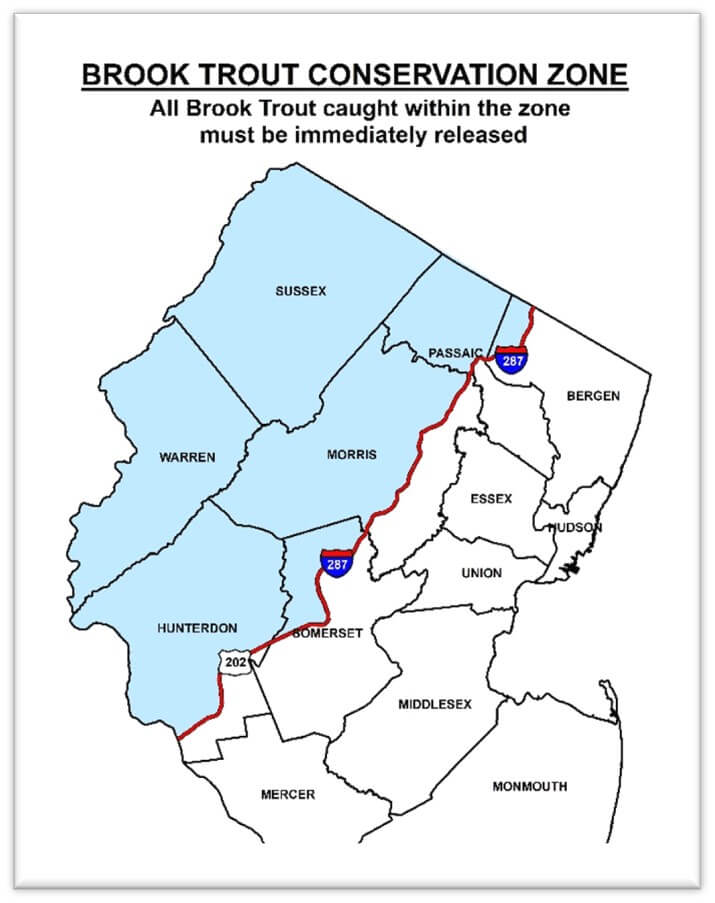Importance of Brook Trout

New Jersey has a variety of wild, self-sustaining salmonids but of the four species that reproduce in our state’s freshwaters, the iconic Brook Trout is the only one that is native to New Jersey. Wild populations of Brook, Brown and Rainbow Trout inhabit hundreds of small, upland streams, found primarily in the northern tier of the state. All wild trout, but especially Brook Trout, require cold, high-quality habitats and are valued as indicators of healthy ecosystems and high water quality. Native Brook Trout populations that were once common within the northern portion of the State have declined significantly. Survival of native Brook Trout has become threatened by a myriad of factors, including increasing temperatures, habitat fragmentation, nonnative species competition, and other natural and anthropogenic disturbances. Native Brook Trout are now present in less than half of the subwatersheds that composed their original range, their populations are fragmented, and their presence in many streams is relegated only to the small headwater sections of the streams. Competition from more tolerant non-native trout species poses additional stressors to these struggling populations. New Jersey Fish and Wildlife (NJFW) manages Native Brook Trout populations and their cold water habitats by monitoring, habitat preservation, restoration, education and communication.
Brook Trout Conservation History
A statewide 7-inch minimum size for trout (both wild and stocked) was established in 1997 to protect wild trout less than 7 inches from being harvested. This size was increased to 9 inches in 2008 which further protected wild trout from harvest while not impacting the harvest of hatchery trout (typically 10-11 inches or larger when stocked). These size limits essentially protected most of New Jersey’s Brook Trout as only a small number of Brook Trout in New Jersey reach sizes greater than 9 inches. Unfortunately, the Brook Trout that did reach a size greater than 9 inches and therefore weren’t protected by the statewide 9 inch size limit, are arguably the most important individuals of the population as they are mature individuals capable of producing large quantity of offspring and greatly contribute to the future survival of the species.
Following a two-year Wild Trout Stream Assessment initiated in 2014, an online wild trout angler survey in 2015, and several meetings between wild trout anglers and special wild trout interest groups and NJ Fish and Wildlife biologists, in 2018 another native Brook Trout conservation milestone was established with the regulation adoption of the Brook Trout Conservation Zone (BTCZ).
The BTCZ regulation adoption states that all Brook Trout caught within the BTCZ must be immediately released unharmed. The BTCZ consists of all waters within the northwest region of the State, where most of our remaining wild Brook Trout populations occur. The BTCZ is bounded by easily discernable boundaries; two major roadways (Interstate 287 and Route 202), the Delaware River, and the NJ-NY state line. This regulation protects all Brook Trout within the BTCZ, including wild Brook Trout that may move from small tributary streams to the mainstem of larger rivers and grow larger than 9 inches, allowing them to survive, reproduce and perpetuate the species.
A component of the catch and release regulation for Brook Trout is that hatchery Brook Trout will no longer be stocked within the BTCZ (because they may not be harvested and to prevent interbreeding with wild Brook Trout). A genetics study completed in 2007 indicated that there are wild Brook Trout populations in New Jersey streams that are most likely descendants of fish that colonized our area after the last glacier retreated. Preventing interbreeding helps safeguard our native Brook Trout gene pools, preserving their genetic variability and potential to evolve in response to environmental change.
Fish and Wildlife’s trout stocking program is currently unaffected as only Rainbow Trout are currently reared and stocked statewide. If Brook Trout are re-introduced into the state hatchery system they will only be stocked outside of the BTCZ. In addition, private fishing clubs and others who apply for fish stocking permits will not be approved to stock Brook Trout within the BTCZ.
Ultimately, as a result of this change every Brook Trout caught within the BTCZ will be a native Brook Trout!
In addition to the BTCZ the Wild Trout Stream Regulation was also changed. What was once one regulation in the past, is now a subset of three categories highlighting the variety of wild trout fishing opportunities available, while aligning regulations with specific management strategies. Wild Trout Stream regulations now include these three categories: Native Brook Trout Streams, Wild Trout Streams, and Brown Trout Enhancement Streams.
Learn More About Wild Trout Streams
Native Brook Trout Streams (Brook Trout Dominant)– This category highlights 11 streams that are almost exclusively inhabited by native Brook Trout. There is no minimum size limit for competing salmonids, and Fish and Wildlife encourages harvest for Brown and Rainbow Trout in these native Brook Trout waters. These efforts are aimed at reducing competition with non-native trout species. All Brook Trout, however, must be immediately released unharmed.

 Official Site of The State of New Jersey
Official Site of The State of New Jersey


